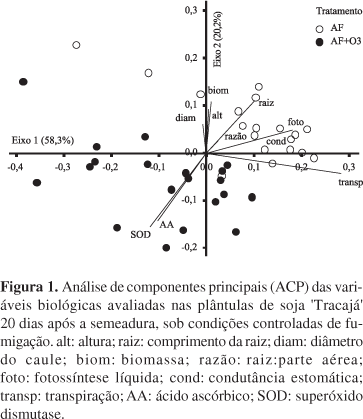The objective of this work was to assess initial growth, biomass production, gas exchange and antioxidative defenses of soybean 'Tracajá' seedlings, cultivated in the Amazonian region, exposed to ozone under controlled conditions. Seeds germinated in pots were placed in two chambers, one with filtered air (AF) and other with filtered air plus 30 ppb of ozone (AF + O3). At 10 and 20 days after sowing, gas exchange, growth and biomass were measured; at 20 days after sowing, antioxidative defenses (ascorbic acid and superoxide dismutase) were analyzed. Net photosynthesis, stomatal conductance, transpiration rate, height, leaf area and biomass were 16, 27, 11, 22, 29 and 18% smaller, respectively, in AF + O3 at 10 days after sowing. At 20 days after sowing, besides this parameters, root length, stem diameter and root:shoot ratio were 10, 15 and 12% smaller, respectively, although ascorbic acid concentrations and superoxide dismutase activity increased. Soybean 'Tracajá' seedlings have low tolerance to concentration of 30 ppb of ozone.
Glycine max; air pollution; antioxidants; gas exchange; growth



